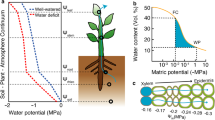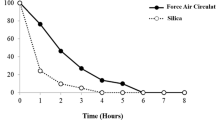Summary
First year seedlings of English oak (Quercus Cobur) and silver birch (Betula pendula) were subjected to pressure-volume analysis to investigate the water potential components and cell wall properties of single leaves. It was hoped that this rapid-drying technique would differentiate between reductions in plant solute potential resulting from dehydration and the effects of solute accumulation.
Comparison of results from these experiments with those of slow drying treatments (over a number of days) with plants growing in tubes of soil, indicated that some solute accumulation may have occurred in drying oak leaves. High leaf turgor and leaf conductance were maintained for a significant period of the drying cycle. Roots of well-watered oak plants extended deep into the soil profile, and possibly as a result of solute regulation and therefore turgor maintenance, root growth of unwatered plants was greater than that of their well-watered counterparts. This was particularly the case deep in the profile. As a result of deep root penetration, water deep in the soil core was used by oak plants to maintain plant turgor, and quite low soil water potentials were recorded in the lower soil segments.
Root growth of well-watered birch seedlings was prolific but roots of both well-watered and unwatered plants were restricted to the upper part of the profile. Root growth of unwatered plants was reduced despite the existence of high soil water potentials deep in the profile. Shallow rooting birch seedlings were unable to use this water.
Pressure-volume analysis indicated that significant reductions of water potential, which are required for water uptake from drying soil, would occur in oak with only a small reduction in plant water content compared to the situation in birch. This was a result of the low solute potential in oak leaves combined with a high modulus of elasticity of cell walls. Deep rooting of oak seedlings, combined with these characteristics, which will be particularly important when soil deep in the profile begins to dry, mean that this species may be comparatively successful when growing on dry sites.
Similar content being viewed by others
References
Cheung JNS, Tyree MT, Dainty J (1975) Water relations parameters of single leaves obtained in a pressure bomb and some ecological interpretations. Canad J Bot 53: 1342–1346
Cheung JNS, Tyree MT, Dainty J (1976) Some possible sources of error in determining bulk elastic moduli and other parameters from pressure volume curves of shoots and leaves. Canad J Bot 54: 758–765
Cowan IR (1965) Transport of water in the soil-plant-atmosphere system. J appl Ecol 2: 221–239
Elston J, Karamanos AJ, Kassam AH, Wadsworth RM (1976) The water relations of the field bean crop. Phil Trans R Soc Lond B273: 581–591
Fiscus EL (1975) The interaction between osmotic and pressure induced water flow in plant roots. Plant Physiol 55: 917–922
Gardner WR (1960) Dynamic aspects of water availability to plants. Soil Sci 89: 63–73
Hellkvist J, Richards GP, Jarvis PG (1974) Vertical gradients of water potential and tissue water relations in sitka spruce trees measured with the pressure chamber. J appl Ecol 11: 637–667
Herkelrath WN, Miller EE, Gardner WR (1977a) Water uptake by plants. I. Divided root experiments. Soil Sc Soc Am J 41: 1033–1038
Herkelrath WN, Miller EE, Gardner WR (1977b) Water uptake by plants. II. The root contact model. Soil Sci Soc Am J 41: 1039–1043
Holch AE (1931) Development of roots and shoots of certain deciduous tree seedlings in different forest sites. Ecology 12: 259–298
Hough WA, Woods FW, McCormack ML (1965) Root extension of individual trees in surface soils of a natural long leaf pine-turkey oak stand. Forest Sci 11: 223–242
Hsiao TC, Acevedo E (1974) Plant responses to water deficits, water use efficiency and drought resistance. Ag Meteorol 14: 59–84
Hsiao TC, Fereres E, Acevedo E, Henderson DW (1976) Water stress and dynamics of growth and yield of crop plants. In: OL Lange et al. (eds) Water and Plant Life. Ecological Studies Vol. 19 Springer, Berlin Heidelberg New York pp 281–305
Jones MM, Turner NC (1978) Osmotic adjustment in leave of Sorghum in response to water deficits. Plant Physiol 61: 122–128
Newman EI (1966) A method of estimating the total length of root in a sample. J appl Ecol 3: 139–145
Osonubi O, Davies WJ (1978) Solute accumulation in leaves and roots of woody plants subjected to water stress. Oecologia (Berl) 32: 323–332
Osonubi O, Davies WJ (1980) The influence of water stress on stomatal control of gas exchange at different levels of atmospheric humidity. Oecologia (Berl) 46: 1–6
Nicholson BE, Clapham AR (1975) The Oxford Book of Trees. Oxford University Press pp 216
Roberts SW, Knoerr KR (1977) Components of water potential estimated from sylem pressure measurements in five tree species. Oecologia (Berl) 28: 191–202
Sharp RE, Davies WJ (1979) Solute regulation and growth by roots and shoots of water-stressed maize plants. Planta 147: 43–49
Sharp RE, Osonubi O, Wood WA, Davies WJ (1979) A simple instrument for measuring leaf extension in grasses, and its application in the study of the effects of water stress on maize and sorghum. Ann Bot 44: 35–45
Tennant D (1975) A test of a modified line-intercept method of estimating root length. J Ecol. 63: 995–1001
Toumey JW (1929) Initial root habit of American trees and its bearing on regeneration. Proc 4th Int Bot Congr 1: 713–728
Tyree MT (1976) Physical parameters of the soil-plant-atmosphere system: breeding for drought resistance characteristics that might improve wood yield. In: MG Cannell, FT Last (eds) Tree Physiology and yield Improvement. pp 329–348 Academic Press, London
Tyree MT, Dainty J, Benis M (1973) The water relations of hemlock (Tsuga cana Jensis). I. Some equilibrium water relations as measured by the pressure bomb technique. Can J Bot 51: 1471–1477
Weatherley PE (1976) Introduction: water movement through plants. Phil Trans Roy Soc Lond B 273: 435–444
Wilson JR, Fisher MJ, Schulze E-D, Dolby GR, Ludlow MM (1979) Comparison between pressure-volume and dewpoint hygrometry techniques for determining the water relations characteristics of grass and legume leaves. Oecologia (Berl) 41: 77–88
Wilson JR, Ludlow MM, Fisher MJ, Schulze E-D (1980) Adaptation to water stress of the leaf water relations of four tropical forage species. Aust J Plant Physiol 7: 207–220
Author information
Authors and Affiliations
Rights and permissions
About this article
Cite this article
Osonubi, O., Davies, W.J. Root growth and water relations of oak and birch seedlings. Oecologia 51, 343–350 (1981). https://doi.org/10.1007/BF00540904
Received:
Issue Date:
DOI: https://doi.org/10.1007/BF00540904




